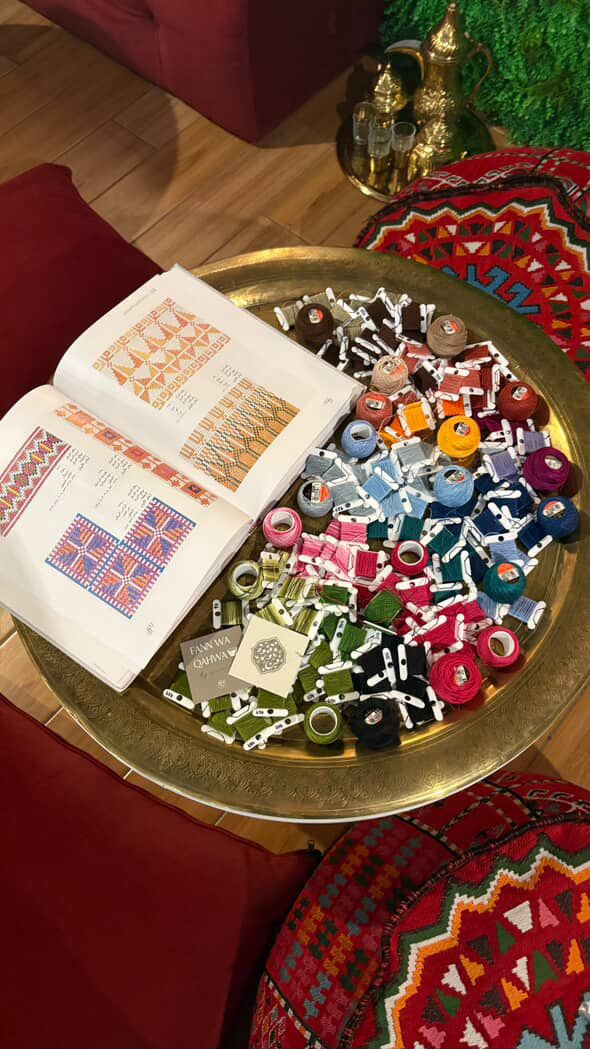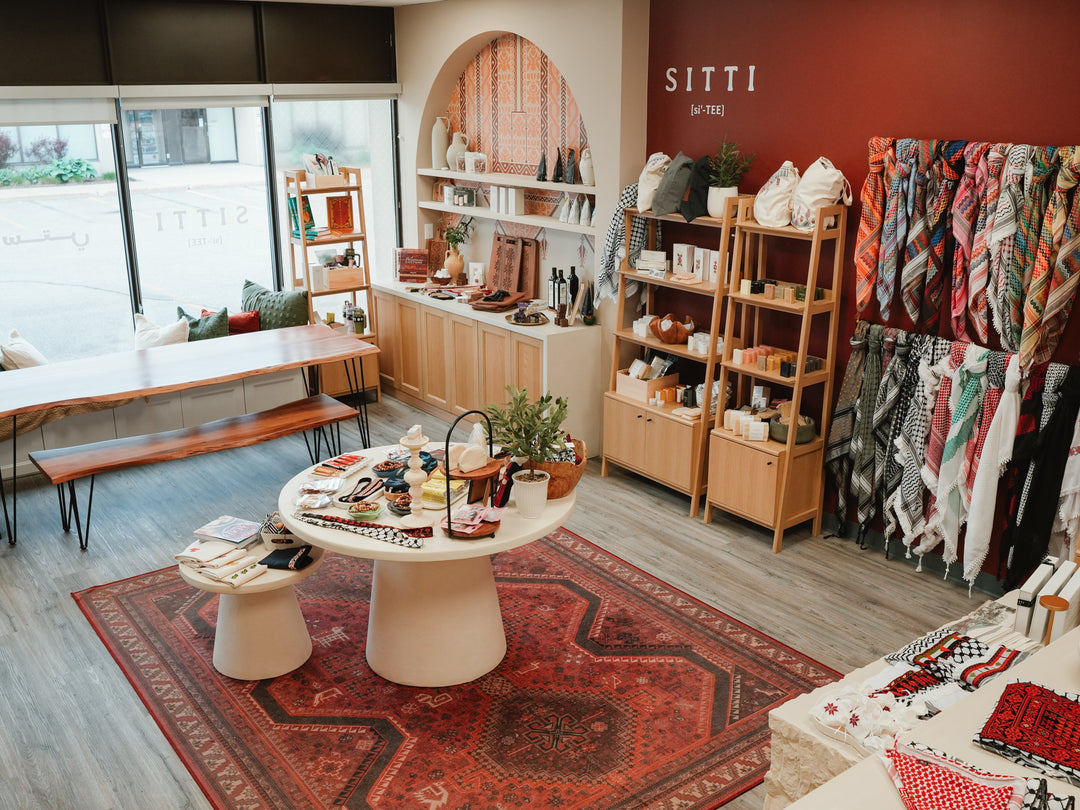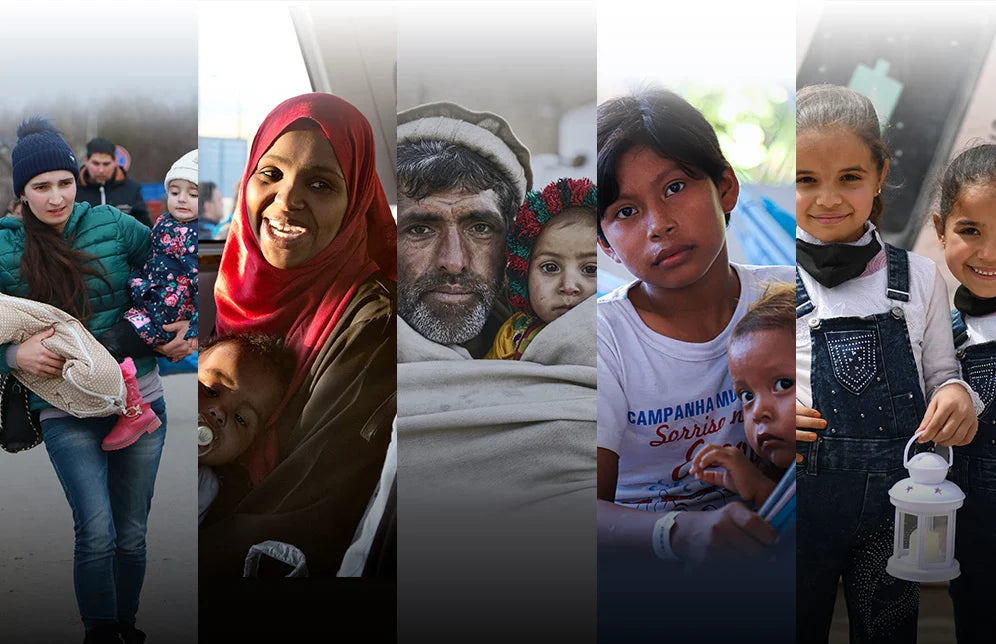World Keffiyeh Day - May 11: Reclaiming the Narrative
More Than a Symbol—A Story of Resilience
This past Friday night, I sat in a café, forcing myself to care about schedules and spreadsheets I’d ignored for weeks. Like so many in our community right now, I struggle to focus on anything—let alone mundane tasks—while our people in Gaza endure genocide.
Something broke through the numbness this time around.
A server approached me, her smile wide and warm. "Are you from Palestine?" she asked. Even though I shared that I was not Palestinian, we instantly fell into the easy rhythm of sharing roots and exchanging stories, the way Arabs and Middle Easterners do. She told me that she was from Hebron, and shared that seeing the keffiyeh tied to my bag had made her long shift a little lighter.
Seeing a keffiyeh wrapped around the shoulders of a stranger on a busy street, in a café, or frankly anywhere that isn’t a protest—is the most comforting feeling I’ve known in years. Some days, it’s the only comfort I find for weeks at a time. It’s something that creates a silent bond, where no words are needed. Just the sight of it tells me everything; We are not alone.
The keffiyeh, once a universal symbol of Palestinian heritage—has been twisted into something it’s not; a sign of aggression, a “threat.” But those of us who know its true meaning understand it as something far deeper. It’s a story of resistance woven in fabric, and a lifeline connecting us across borders, generations and diasporas.
On World Keffiyeh Day, we reclaim its narrative.
The Keffiyeh: A Cultural Heirloom
Long before it became a global symbol of solidarity, the keffiyeh was a practical garment worn by farmers (fellahin) and Bedouins across the Middle East. Made of durable cotton, it shielded wearers from the relentless sun and swirling desert sands.
But in Palestine, it took on another meaning. During the British Mandate, it became a marker of identity. Later, as displacement and occupation intensified, the keffiyeh transformed into a symbol of unyielding resilience. Figures like Yasser Arafat, Ghassan Kanafani and Leila Khaled wore it not as a fashion statement, but as a declaration; Letting the occupation know that we are still here, and we will remain on our land.
In Palestinian homes, a keffiyeh is rarely just a scarf—it’s a family heirloom. Mother and fathers tuck them into suitcases for their children studying abroad, and grandparents continue to press faded ones into the hands of their grandchildren. Keffiyehs don’t gather dust in drawers, but instead they live on shoulders, in protests, and displayed in homes as a reminder to never forget.
Symbolism Woven Into Every Thread
Look closely at a Palestinian keffiyeh, and you’ll see more than just a pattern—you’ll see a map of history, struggle, and connection.
The symbolism of olive leaves around the border of the keffiyeh, symbolizes the steadfastness (sumud) of the Palestinian people; This mirrors the olive trees that Palestinians have tended for generations—trees that are often uprooted by the occupation, yet still, new saplings are planted.
The bold lines around the perimeter of the keffiyeh that surround the olive leaves, represent the trade routes of ancient Palestine—a land that was once a thriving crossroads of the Silk Road, now fragmented by walls and checkpoints.
The fishnet pattern that takes up the majority of the fabric, is a tribute to Gaza’s fishermen, whose access to the Mediterranean sea has been stolen, yet who still cast their nets in defiance.
Even the stitching of the keffiyeh tells us all a story. Each keffiyeh carries imperfections reminding us that resilience isn’t about perfection, but persistence.
Solidarity, Not Stereotypes
In recent months, the keffiyeh has been labeled “controversial,” even banned in some spaces such as Canada's House of Commons. Why is the keffiyeh—a cultural emblem—treated differently than any other cultural symbol?
The answer is simple; Because Palestine makes people uncomfortable. The keffiyeh forces the world to acknowledge a reality many would rather ignore—that for over 75 years, Palestinians have survived apartheid and resisted erasure.
Yet, when I see someone wearing one, I don’t see “aggression.” I see a student in London standing in solidarity, an elder in Jerusalem keeping tradition alive, protesters in the streets of Toronto refusing to let Gaza be forgotten, and people of concise united against oppression. It’s not a symbol of hate—it’s a whisper across a crowded room saying “I will not forget, and I will resist with you.”


World Keffiyeh Day: Reclaiming the Narrative
This World Keffiyeh Day, we honour its true meaning; As cultural heritage – Not a trend, but a testament to survival. As solidarity – Worn by those who stand with Palestine, not as performative activism, but as commitment. As resistance – A refusal to let a people’s story be rewritten.
“The Kuffiyeh serves as a thread connecting our past to our present. Historically, it was worn by the peasantry and working people in our land and region. Growing up, I saw it as an essential part of our culture and heritage. Today, it symbolizes our revolt and rebellion against the tyranny and injustice we face – imperialism and zionism. It engraves fortitude, glory, and duty into our daily lives. For me, this fabric stitches the bond between our people and our supporters around the world. I see it adorning the necks & shoulders of my comrades, covering the faces of dissenters, gracing the heads of the elderly, cradling newborn children, enhancing our artistic expressions, and decorating both funerals and festivals. It serves as a reminder that our struggle resonates in the hearts of all free people.” - Mohammed Alqasem, Community organizer & Trade-Unionist based in Toronto
“I still wear my Kuffiyeh with pride daily. I still talk about Palestine every chance I get. I make more informed decisions about how I spend my money, and I have ended friendships over the "politics" of murdering children.
How Can We All Participate in World Keffiyeh Day?
1. Educate – Share the history behind the keffiyeh’s patterns and regrounding the keffiyeh in its purpose.

2. Support – Buy keffiyehs from Palestinian makers such as Hirbawi, the last factory in Hebron.

3. Wear it proudly – Not as a fashion statement, but as a statement of principle and solidarity.
The keffiyeh is not a threat—it’s a living archive. In its threads are the voices of fishermen denied their sea, farmers barred from their olive groves, and families rebuilding after bombs. So the next time you see a keffiyeh, remember that behind every fold is a story that refuses to fade.
"They tried to bury us. They didn’t know we were seeds." - Dinos Christianopoulos.
#WorldKeffiyehDay
Written by Celina S.
Photograph 1, by Natalia Marianna
Photograph 2, by Peter Turnley via Getty Images
Photograph 3, courtesy of Hirbawi Factory
Photograph 4, by Abdelhak Senna via Getty Images
Photograph 5, by Harry Koundakjian via AP
Photograph 6, by Hazem Bader via Getty Images
Photograph 7, courtesy of Hirbawi Factory
Photograph 8, by Natalia Marianna










Leave a comment